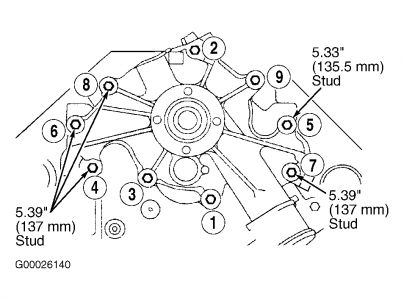WATER PUMP
Removal
Disconnect negative battery cable. Drain cooling system. Remove accessory drive belt. Raise and support vehicle. Remove lower radiator hose. Remove nut on both front engine mounts. Lower vehicle. Remove generator. Disconnect power steering pump pressure hose. Remove cowl top vent panel. See COWL TOP VENT PANEL .
Disconnect water by-pass hose. Remove water pump outlet tube retaining bolt, and position tube assembly aside. Attach lifting equipment to left exhaust manifold. Raise engine approximately 5" (127 mm). Remove accessory belt pulley nut, and remove pulley. Remove generator support bracket.
Remove water pump pulley. Remove water pump bolts, nuts and studs, noting location of studs. Remove water pump, lower tube and gasket as an assembly.
Installation
Install gasket using Gasket & Trim Adhesive (D7AZ-19B508-B). To complete installation, reverse removal procedure. Lightly oil threads of bolt and stud not containing thread sealant.
If bolts originally contained thread sealant, clean and reapply thread sealant to bolts. Install studs into original location. Tighten bolts and nuts in sequence to specification. See Fig. 19 . See TORQUE SPECIFICATIONS . Fill cooling system.
Fig. 19: Water pump Bolt & Nut Tightening Sequence
Courtesy of FORD MOTOR CO.

Wednesday, April 10th, 2019 AT 6:19 PM
(Merged)

